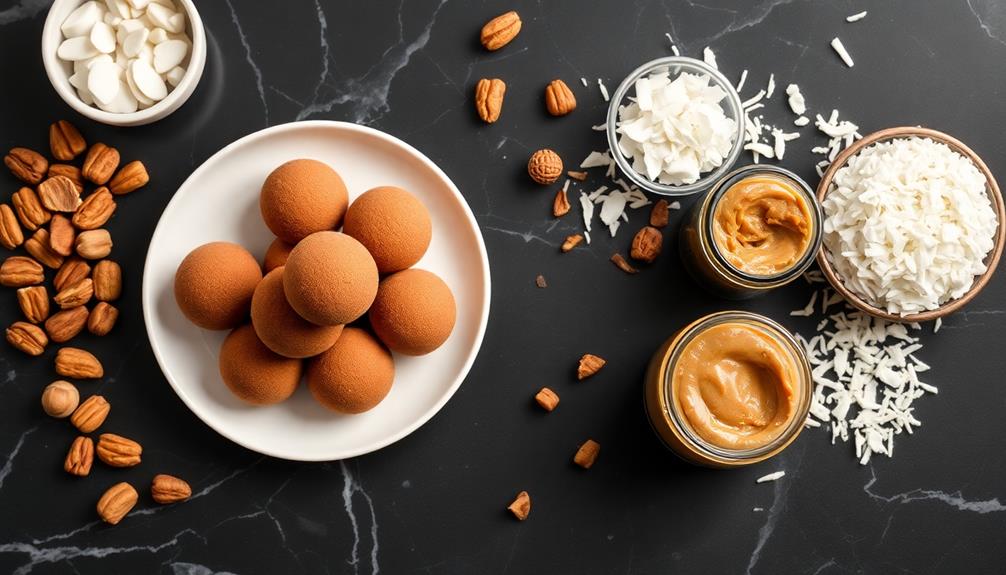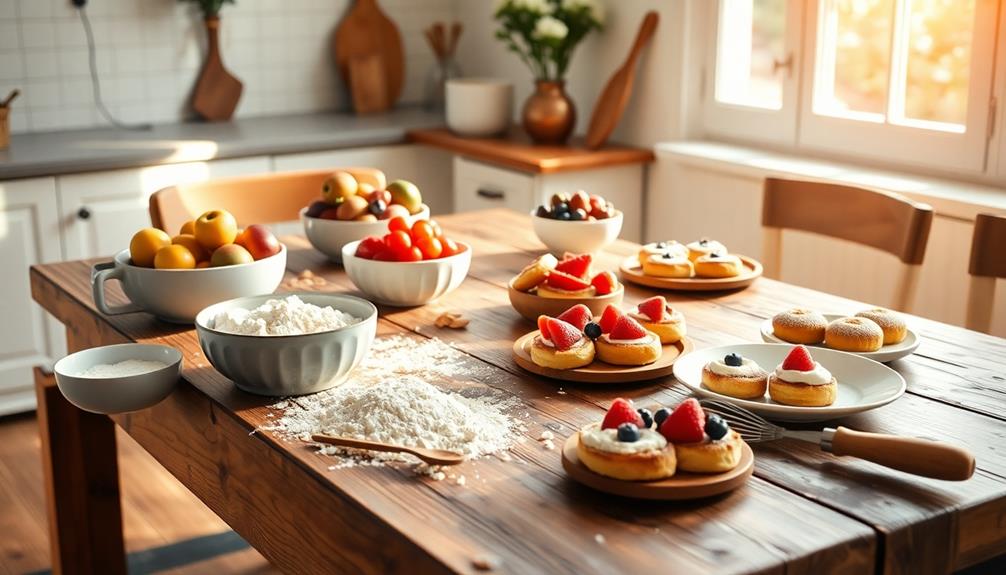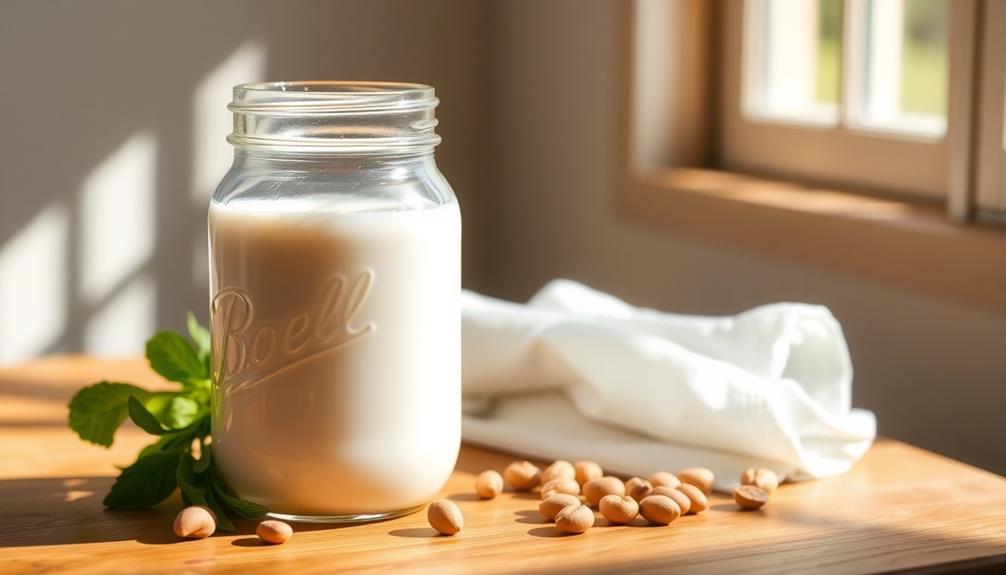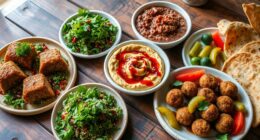Beyond the typical cereal and milk, you'll discover a world of dairy-free breakfast options that'll elevate your morning routine. Ancient civilizations enjoyed flavorful miso soups and hearty legume-based dishes, while modern plant-based adaptations like overnight oats and avocado toast offer creative, nutrient-dense choices. Explore diverse ingredients like fruits, nuts, and seeds to boost fiber, vitamins, and healthy fats – all while catering to dietary preferences and restrictions. The evolution of dairy-free breakfasts reflects culinary innovation, so get ready to mix and match your way to a delicious and satisfying start to your day. There's more to discover beyond the typical bowl.
Key Takeaways
- Explore global breakfast traditions, from rice porridge to herb-infused stews, for diverse and flavorful dairy-free options.
- Incorporate nutrient-dense plant-based ingredients like fruits, nuts, and seeds to create satisfying and health-conscious dairy-free breakfasts.
- Experiment with versatile recipes, from savory tofu scrambles to sweet fruit smoothies, to cater to various dietary preferences and restrictions.
- Leverage simple cooking techniques and substitutions to transform traditional breakfast dishes into dairy-free creations that are quick and easy to prepare.
- Embrace the opportunity to step outside of the cereal and milk routine and discover new favorite dairy-free breakfast items that align with your personal tastes.
History
Dating back centuries, the history of dairy-free breakfast options is a fascinating exploration of culinary innovation and dietary evolution. From ancient civilizations to modern times, people have sought out nourishing morning meals without relying on dairy products.
In traditional Asian cuisines, rice porridge, miso soup, and vegetable-based dishes have long been staple dairy-free breakfasts. Similarly, in parts of Africa and the Middle East, flatbreads, legumes, and herb-infused stews have sustained communities for generations.
As global migration and cultural exchange have progressed, these diverse breakfast traditions have gained worldwide popularity, inspiring plant-based adaptations and modern interpretations.
Today, the dairy-free breakfast landscape is more vibrant than ever, with a wealth of creative, nutritious, and delicious options that cater to an array of dietary preferences and restrictions.
This rich history underscores the ingenuity and resilience of human culinary traditions, constantly evolving to nourish and delight.
Recipe
Overnight oats are a simple and delicious dairy-free breakfast option that can be prepared ahead of time. The oats soak in almond milk overnight, resulting in a creamy and satisfying texture. This recipe incorporates fresh berries for a burst of sweetness and antioxidants.
For those looking for a refreshing treat after breakfast, consider making frozen yogurt pops as a cool summer snack.
Almond milk is a great dairy-free alternative as it's low in calories and high in vitamins and minerals. The combination of oats, almond milk, and berries provides a well-balanced meal that will keep you fueled throughout the morning. Additionally, almond milk is a good source of plantbased sources of calcium, which is essential for maintaining strong bones and teeth. Furthermore, the oatmeal in this meal provides fiber and complex carbohydrates, which will help keep you feeling full and satisfied. Overall, this breakfast option is a nutritious and satisfying choice for those looking to incorporate more plant-based foods into their diet.
Ingredients:
- 1 cup rolled oats
- 1 cup unsweetened almond milk
- 1/2 cup fresh blueberries
- 1/2 cup fresh raspberries
- 1 tablespoon maple syrup (optional)
- 1/2 teaspoon vanilla extract
Instructions:
In a mason jar or container with a tight-fitting lid, combine the rolled oats and almond milk. Stir to combine, cover, and refrigerate for at least 4 hours or up to 5 days.
When ready to serve, top the overnight oats with the fresh blueberries and raspberries. Drizzle with maple syrup, if desired, and add a sprinkle of vanilla extract.
Tips:
For extra protein, you can add a tablespoon of nut butter or a scoop of plant-based protein powder to the overnight oats. Additionally, you can experiment with different fruit combinations, such as diced apples, sliced bananas, or chopped mango.
Cooking Steps
Toast the bread to your desired level of crispiness.
Spread the creamy avocado evenly over the toast, then sprinkle on some chopped nuts for a crunchy texture.
Finish by adding sliced tomatoes and drizzling with a touch of high-quality olive oil.
Step 1. Toast the Bread

Typically, you'll want to toast your bread before assembling your dairy-free breakfast. This helps create a crisp, golden-brown texture that contrasts nicely with the soft toppings.
To toast the bread, simply place the slices in a toaster or toaster oven and let them cook until they reach your desired level of doneness. Keep an eye on them, as different types of bread can toast at varying speeds.
Once the bread is toasted, you can start building your dairy-free breakfast. Spread your favorite non-dairy spread, such as nut butter or avocado, onto the warm toast.
Top it off with fresh fruit, nuts, or a sprinkle of cinnamon for a delicious and satisfying meal. The toasted bread provides a sturdy base that can hold up to a variety of toppings without getting soggy.
With a few simple steps, you can create a tasty and nutritious dairy-free breakfast that will power you through your day.
Step 2. Spread Avocado on the Toast
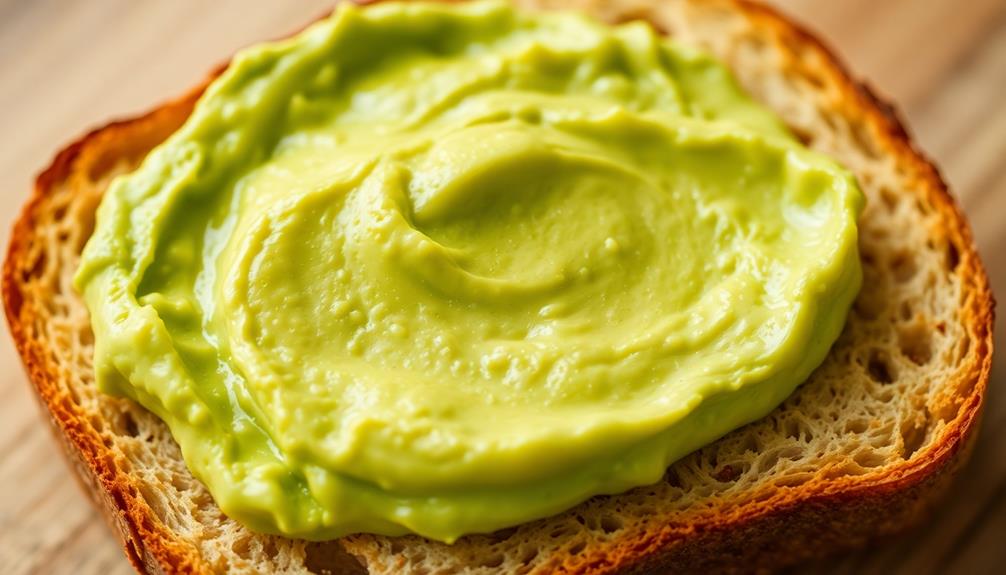
After toasting your bread to perfection, it's time to move on to the next step – spreading avocado on the toast.
Avocados are a fantastic dairy-free option that add creamy, rich flavor and nutrition to your breakfast. Simply take a ripe avocado and use a knife to slice it in half lengthwise. Remove the pit, then use a spoon to scoop out the flesh into a small bowl.
Use a fork to mash the avocado until it's smooth and spreadable. Taste it and add a pinch of salt and pepper if desired.
Then, using a butter knife or the back of a spoon, evenly spread the mashed avocado over the surface of your toasted bread. The cool, creamy avocado pairs beautifully with the warm, crunchy toast.
This simple, nutritious topping can transform ordinary toast into a delicious, satisfying dairy-free breakfast.
Step 3. Sprinkle With Chopped Nuts
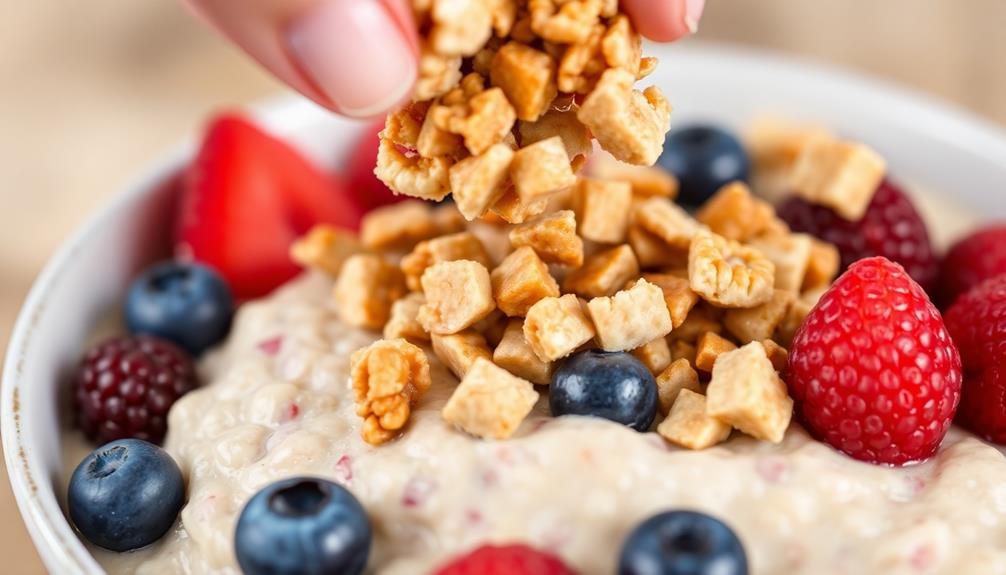
A sprinkle of chopped nuts adds a delightful crunch and nutty flavor to your dairy-free avocado toast. Reach for your favorite variety – almonds, walnuts, pecans, or a mix – and give them a quick chop on a cutting board.
Sprinkle the chopped nuts over the creamy avocado, distributing them evenly across the surface. The nuts not only provide a satisfying texture, but they also boost the nutritional value of your breakfast, adding healthy fats, protein, and fiber.
For extra flavor, you can toast the nuts in a dry skillet for a few minutes before chopping and sprinkling. This simple step enhances their aroma and crunch.
Top it off with a sprinkle of sea salt, a squeeze of lemon, or a drizzle of honey for a delicious and nourishing dairy-free breakfast. The combination of creamy avocado and crunchy, nutty topping is sure to keep you satisfied until lunchtime.
Step 4. Garnish With Sliced Tomatoes
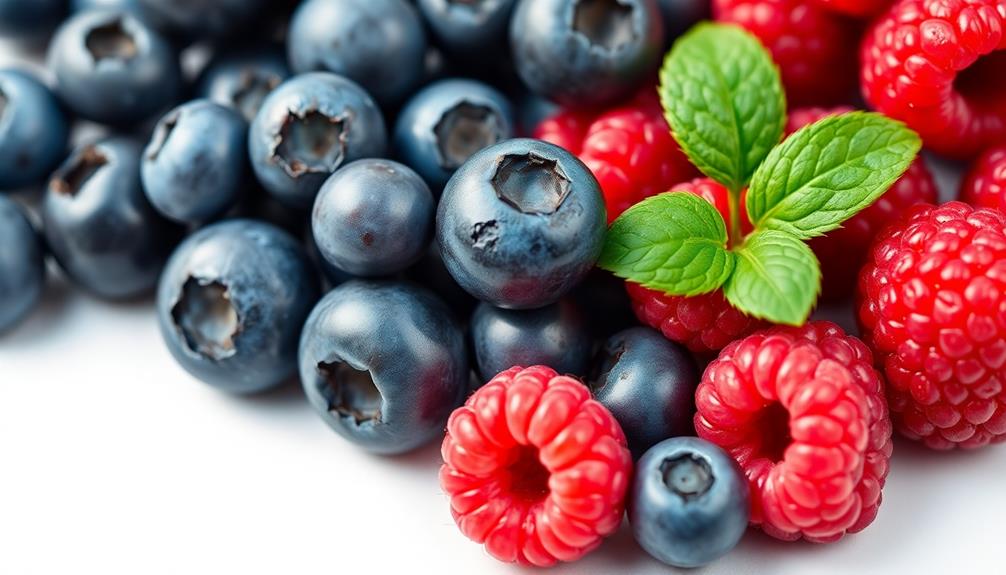
To complete your dairy-free avocado toast, you can garnish it with sliced tomatoes. Ripe, juicy tomatoes add a burst of flavor and vibrant color to your breakfast. Simply slice them into thin rounds or wedges and arrange them on top of the creamy avocado. The coolness of the tomatoes provides a refreshing contrast to the rich avocado.
You can use a variety of tomato types, from classic red beefsteak to sweet cherry tomatoes. If you have access to heirloom tomatoes, their unique shapes and flavors can really elevate your toast.
Feel free to experiment with different tomato combinations, such as a mix of red, yellow, and green slices. Just be sure the tomatoes are ripe and juicy for the best texture and taste.
Garnishing your dairy-free avocado toast with sliced tomatoes is a simple way to add nutrition, flavor, and visual appeal to your morning meal. It's a delicious and nutritious way to start your day on a dairy-free diet.
Step 5. Drizzle With Olive Oil
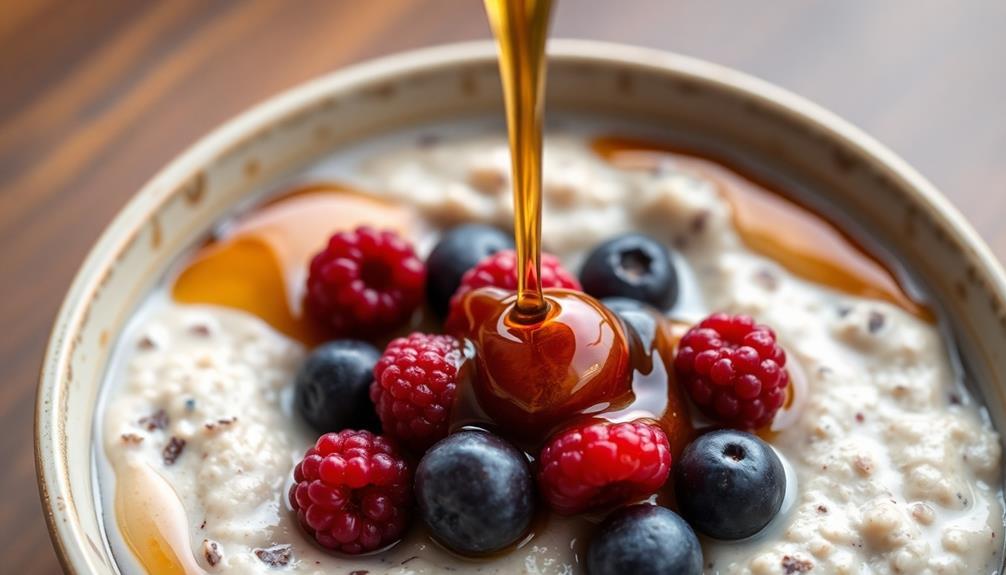
Drizzling a touch of high-quality olive oil over your dairy-free avocado toast enhances the flavors and provides a pleasing mouthfeel. The subtle grassy notes and richness of the olive oil complement the creamy avocado perfectly.
For an extra protein boost, consider adding toppings like lean meats or seeds, which can elevate your breakfast experience. Start with a small drizzle, around 1-2 teaspoons, and adjust to your taste preferences. Gently distribute the oil across the surface of the toast using the back of a spoon or your fingers.
The olive oil also helps the toppings adhere better to the bread. For extra texture, try sprinkling on some toasted seeds, such as sunflower or pumpkin seeds, after drizzling the oil. The oil will help the seeds stick in place.
You can also add a sprinkle of flaky sea salt or freshly cracked black pepper to balance the flavors. Experiment with different olive oil varieties to find your favorite pairing. The right olive oil can elevate your dairy-free avocado toast to new heights of deliciousness.
Final Thoughts
Ultimately, dairy-free breakfast options offer a world of possibilities to explore. Whether you're vegan, lactose-intolerant, or simply looking to diversify your morning meal, the choices are endless.
From savory tofu scrambles to sweet fruit smoothies, the key is getting creative and experimenting with new ingredients and flavors.
Remember, the beauty of dairy-free breakfasts lies in their versatility. Don't be afraid to think outside the box and try unexpected combinations. For example, why not experiment with a savory breakfast bowl using quinoa, sautéed spinach, and avocado? Or, if you have a sweet tooth, consider making a delicious chia seed pudding topped with fresh berries. The possibilities are endless when it comes to creating delicious glutenfree breakfast recipes that are both satisfying and nutritious. Don’t hesitate to get creative and have fun with your dairy-free breakfasts!
Mix and match your favorite fruits, vegetables, and plant-based proteins to craft a nourishing and satisfying meal that suits your taste buds.
As you embark on this dairy-free journey, keep an open mind and have fun with the process.
With a little creativity and a willingness to step outside your comfort zone, you'll discover that the possibilities for delicious, dairy-free breakfasts are truly endless.
Frequently Asked Questions
Are Dairy-Free Breakfast Options Affordable and Accessible?
Absolutely! Dairy-free breakfast options are increasingly affordable and accessible. From plant-based milks to hearty oatmeal and avocado toast, you'll find a range of delicious, nutritious choices to start your day right without dairy.
How Can I Make Dairy-Free Breakfasts Satisfying and Filling?
To make dairy-free breakfasts satisfying and filling, focus on nutrient-dense whole foods like oats, nut butters, fruits, and vegetables. Experiment with recipes that combine these ingredients to create balanced, energizing meals.
What Are the Health Benefits of a Dairy-Free Breakfast?
A dairy-free breakfast can offer several health benefits. It may reduce inflammation, improve digestion, and lower the risk of lactose intolerance or dairy allergies. Plus, it allows you to explore a wider variety of nutrient-dense foods to fuel your day.
Can Dairy-Free Breakfasts Be Prepared Quickly and Easily?
Yes, dairy-free breakfasts can be prepared quickly and easily. From smoothies to overnight oats, there are plenty of nutritious and delicious options that come together in a snap, making it convenient to start your day dairy-free.
Are There Any Dairy-Free Breakfast Options That Can Be Made Ahead of Time?
Absolutely! You can prepare delicious dairy-free breakfast options in advance. Try making overnight oats, chia pudding, or even breakfast burritos that you can reheat quickly on busy mornings. These make-ahead meals are convenient and nutritious.


